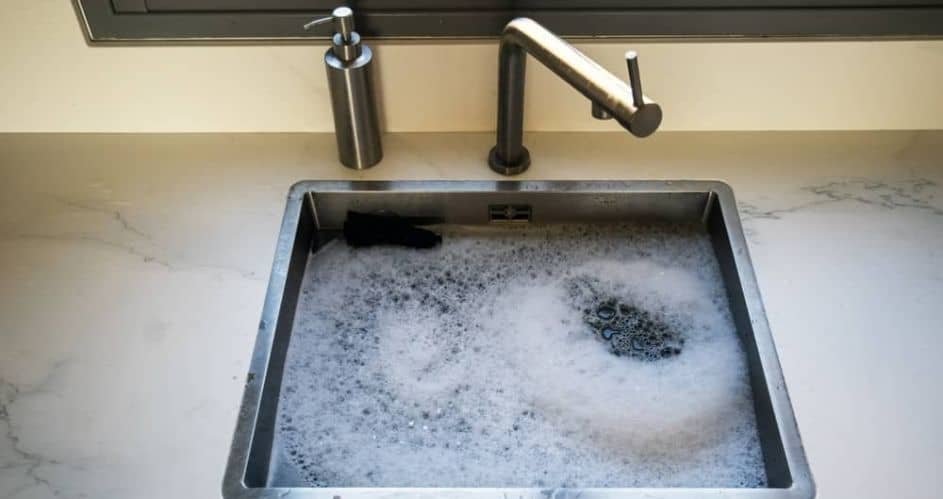
A kitchen sink overflowing can be a messy and frustrating situation to deal with, but there’s no need to panic. There are several solutions you can consider to address this issue and prevent further damage to your kitchen and plumbing.
This piece will look at six practical remedies to help you control and deal with an overflowing kitchen sink.
6 Steps to Save Your Kitchen from Flooding
1. Turn Off the Water Supply
Locating and turning off the water supply valve to your kitchen sink is a critical initial response when dealing with any plumbing issue. Whether it’s a minor leak or a more complex problem, shutting off the water ensures that you have control over the situation, minimizing potential water damage and the risk of flooding.
Familiarizing yourself with the location of this valve ahead of time can save you precious minutes in emergencies and is a fundamental aspect of home maintenance. Once the water supply is off, you can assess the issue more effectively and take appropriate measures to address it.
2. Plunge the Sink
A sink plunger is a handy tool for resolving minor blockages that lead to overflow issues. By creating a proper seal over the drain and applying controlled pressure through gentle plunging, you can effectively break down and remove clogs that obstruct the water flow.
It’s essential to maintain patience and persistence when using a plunger, as it may require multiple attempts to dislodge the blockage fully. The key is to create suction and pressure variations that help break apart and move the debris that’s causing the overflow.
If the plunger method doesn’t resolve the problem, consider trying other techniques or seeking professional plumbing assistance for more severe issues.
3. Check the Garbage Disposal
Inspecting your garbage disposal is a crucial step in troubleshooting sink overflow issues. If you have a garbage disposal unit, it may be responsible for the blockage. Safety should always come first, so start by turning off the disposal to avoid any accidental activation.
After ensuring it’s powered off, visually inspect the disposal for any noticeable obstructions or foreign objects that may be hindering its operation. To properly remove any debris you encounter, use tongs or pliers.
Clearing the disposal of obstructions can often resolve overflow problems and restore proper drainage. However, exercise caution when working with a garbage disposal to prevent injuries.
4. Use an Auger or Drainage Snake
When a plunger is ineffective, a drain snake or auger might be used to solve the problem. These tools are designed to reach further into the plumbing and tackle more stubborn clogs. Simply place one into the drain and spin the handle counterclockwise while easing it farther into the pipe.
The snake’s flexible design allows it to navigate the twists and turns of your plumbing, making it effective at breaking up and removing blockages that might be lurking deeper within. Be sure to proceed slowly and carefully to avoid damaging your pipes, and consider wearing gloves for hygiene and safety reasons.
5. Check the Trap
Checking and cleaning the trap, that U-shaped pipe beneath your sink, can be a vital step in resolving a stubborn blockage. A bucket or container should first be placed beneath the trap to catch any water and debris that may leak out throughout the procedure.
To carefully loosen and remove the trap, use an adjustable wrench. Once removed, take a close look inside the trap for any buildup or clogs. This is often where small objects or debris accumulate, causing drainage problems.
Clean the trap thoroughly, remove any trapped material, and then securely reassemble it. This step can be particularly effective in clearing blockages located near the sink itself.
6. Seek Professional Waste Disposal Repair
If your kitchen sink keeps overflowing despite your best efforts, it’s a clear sign that the problem may be more complex and require professional attention. In such cases, it’s wise to seek the expertise of a professional plumber or technician who specializes in garbage disposal repair.
These professionals have the knowledge and training necessary to precisely pinpoint the issue and offer fixes that will get your sink back in working condition.
Whether it’s a malfunctioning garbage disposal unit or a more complicated plumbing problem, their experience can save you time and ensure your kitchen sink functions properly once again. Don’t be afraid to contact a knowledgeable professional to handle recurring sink overflow difficulties.
Conclusion
Dealing with an overflowing kitchen sink can be a stressful situation, but by taking these six steps, you can effectively address the problem and prevent further damage.
Remember to turn off the water supply, try plunging the sink, check the garbage disposal, use a drain snake or auger, inspect the trap, and, if needed, seek professional Waste disposal repair. By acting promptly, you can restore proper drainage and maintain a functional kitchen sink.
